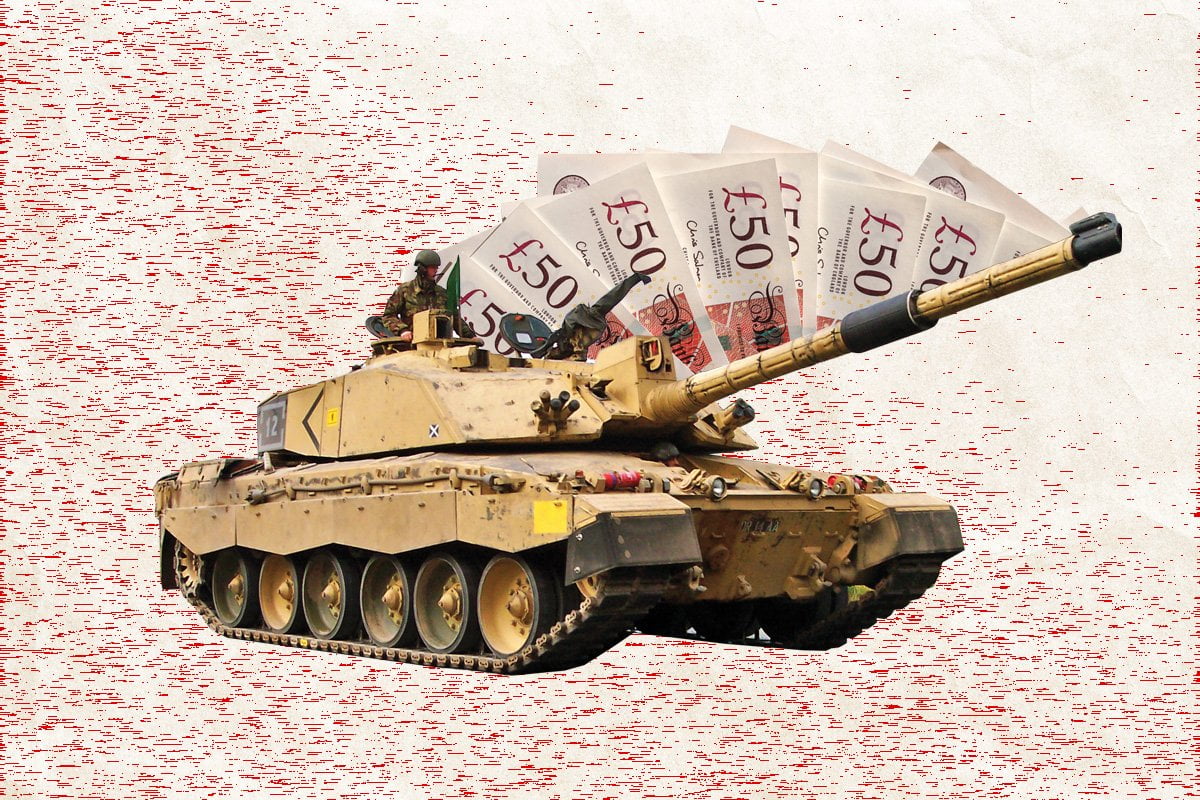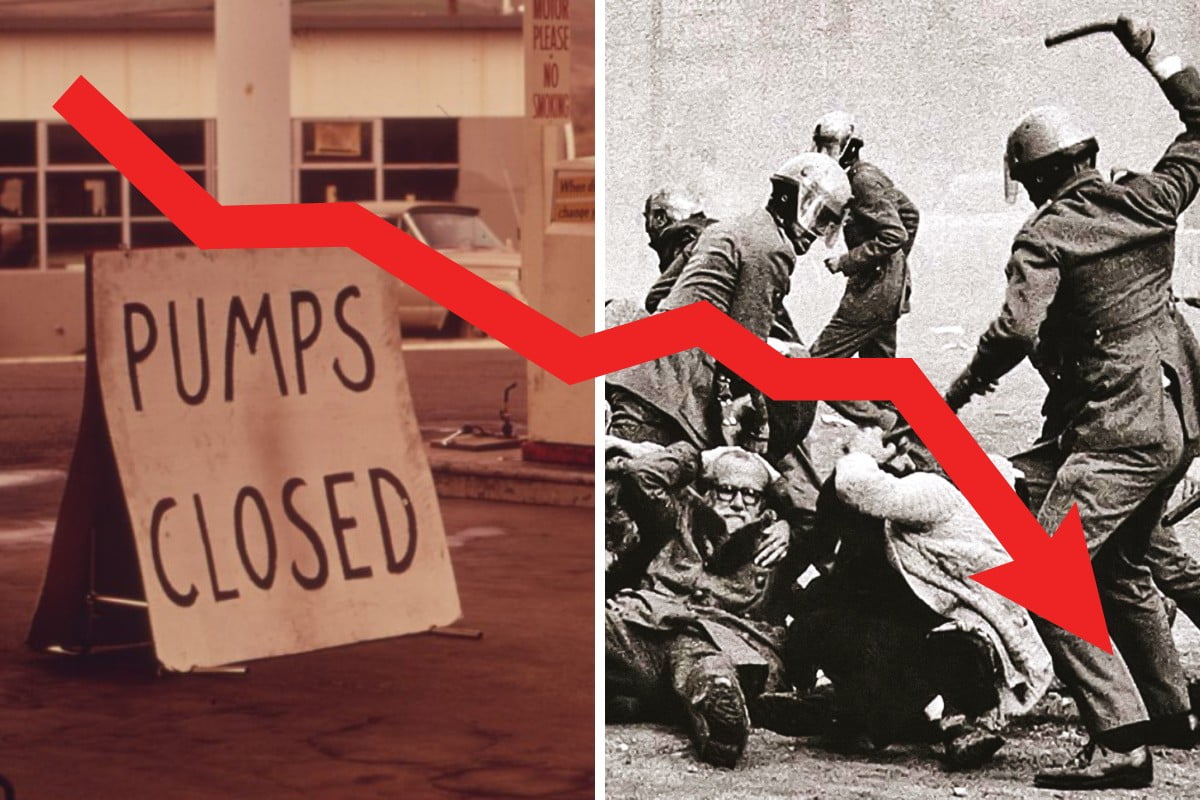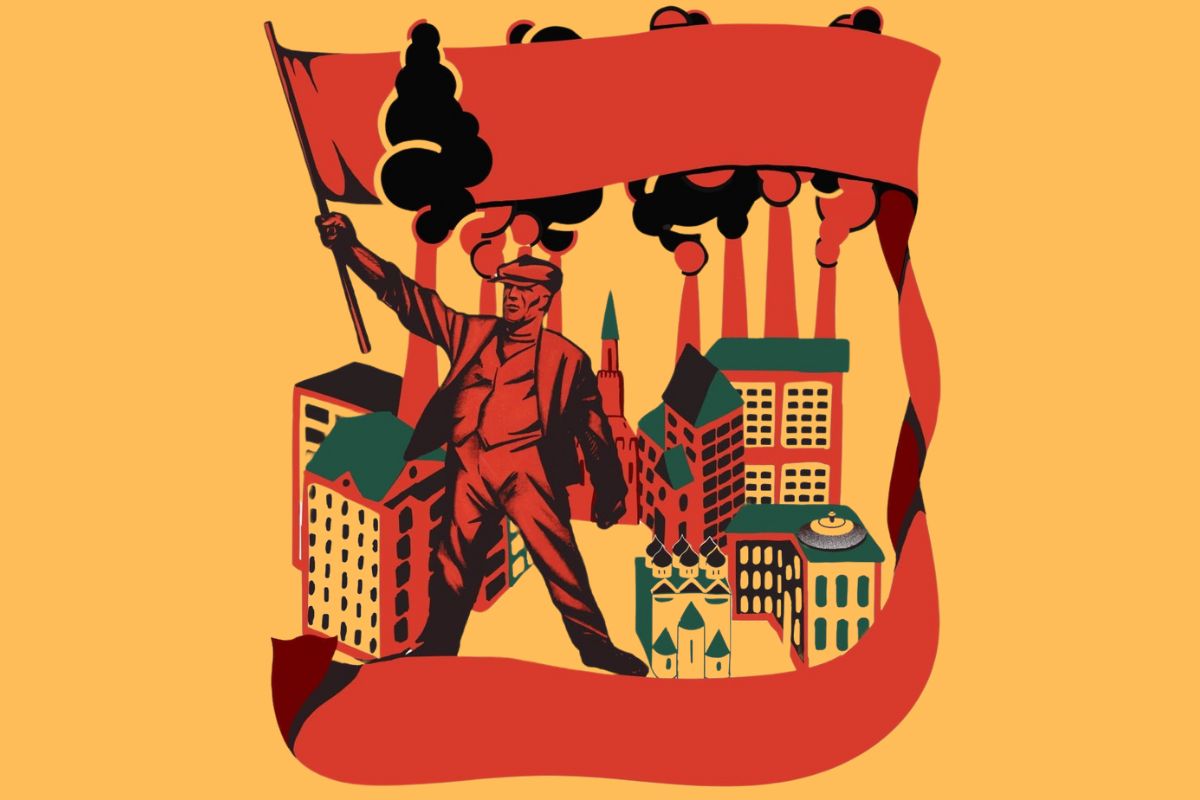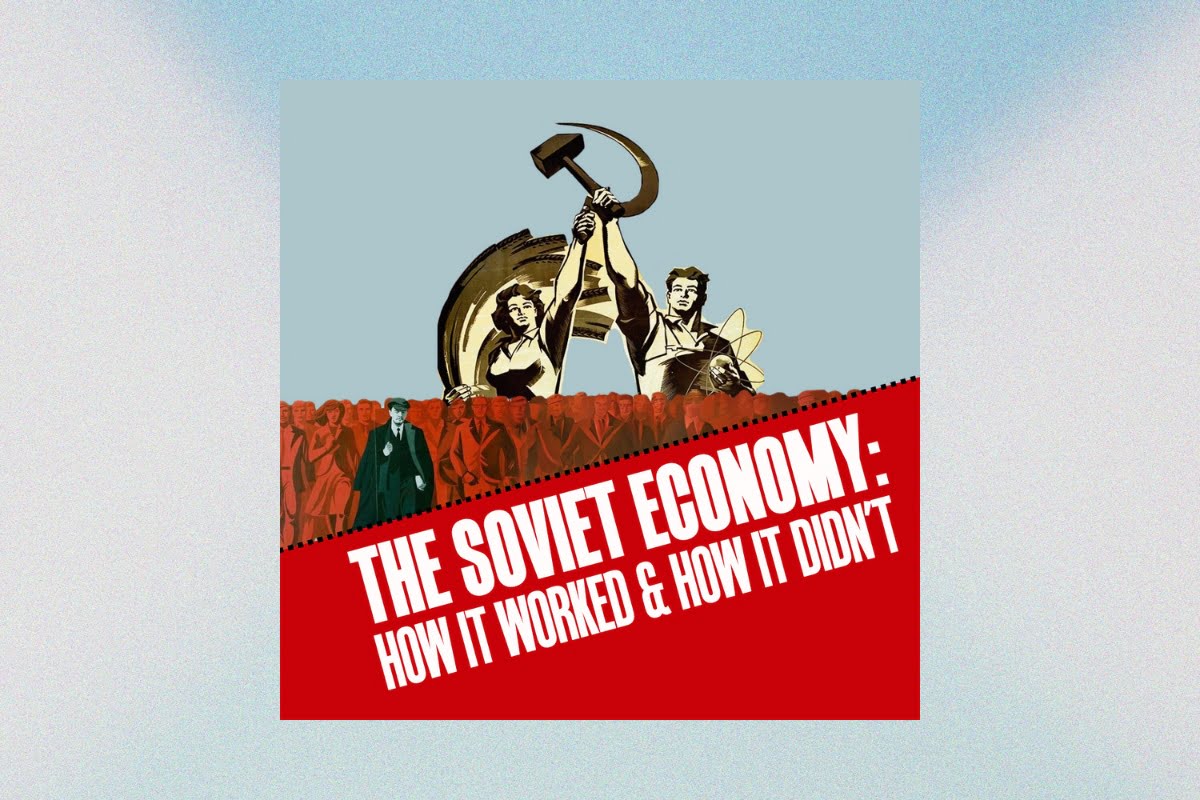The arms race is not a new phenomenon. The years before the First World War saw a tremendous buildup of military spending. This is commented upon in Lenin’s work ‘Imperialism, the highest stage of capitalism’. Lenin, however, confined himself to discussing the military/political imperative to pile up state expenditure on armaments in the epoch of imperialism. He did not discuss the effects of this spending upon the economies of imperialist nations.
Rosa Luxemburg
The first major discussion of this question is in Luxemburg’s book ‘The Accumulation of Capital’. Luxemburg analysed Marx’s reproduction schemes in Volume Two of ‘Capital’. By ‘correcting’ them, she saw the major problem of capitalism as being a tendency towards a relative overproduction of department two (consumer) goods. Capitalism hence needed to conquer non-capitalist sectors to find markets in order to overcome the problem of realising surplus value locked in these consumer goods.
In the chapter ‘Militarism as a province of accumulation’ she claims that taxes upon working class people and intermediate layers drive down their standard of living in order to provide an additional outlet in the arms sector for profitable accumulation by the capitalists. This is a particularly unsatisfactory chapter. Even if we accept Luxemburg’s premises, taxation of workers to hand the money over to capitalists clearly represents a simple transfer of purchasing power within the capitalist economy. This does not solve any ‘realisation’ problem, except insofar as taxation falls upon layers outside the capitalist economy such as peasants.
Bukharin
This approach was opposed by Bukharin in his ‘Economics of the Transformation Period’. He denounced “the monstrous theoretical constructions that draw conclusions about the beneficial (!) influence of war on national economic life”. Bukharin analysed war production as ‘negative expanded production’. By this he meant that war production was waste production for capitalism as a whole which “narrows the basis of social production”. Capitalists engaged in production of war goods are paid the usual rate of profit. So, by racking up the national debt there occurs an accumulation of paper tokens and securities not backed up by marketable goods that lead to inflationary pressures.
After World War II
Since the Second World War there has been an unprecedented peacetime level of government spending and an enormous boom. Keynesian illusions have fed in to Marxist writings suggesting that increased government intervention caused or maintained the
post-War boom. One form of this approach is the theory of the ‘permanent arms economy’. Joan Robinson (a Keynesian economist critical of Marxism) argues in her introduction to Rosa Luxemburg’s ‘The Accumulation of Capital’ that armaments should be treated as providing an “outlet for the investment of surplus… which, unlike other kinds of investment, crates no further problem by increasing productive capacity”. Early formulations of the theory by Natalie Moskowka and Walter J. Oakes and T.N. Vance (both the latter believed to be pseudonyms for Ed Sard) made heavy use of Keynesian concepts. Both saw the central cause of capitalist crisis as the tendency to overproduction.
This however, was not Marx’s view, for the “restricted consumption of the masses” is a permanent condition of capitalism. The early Russian Marxists argued against the Narodniks that capitalism did not restrict but created a market in its development through switching an ever-increasing proportion of total production towards capital accumulation, so swelling the market for capital goods. Lenin, for instance, argued in ‘A Characterisation of Economic Romanticism’, that “it is precisely in the periods which precede crises that workers’ consumption rises”. While, of course, not denying the tendency for capitalism to restrict the workers’ consumption to the narrowest of limits, for Marx the level of income of both workers and capitalists was determined by the accumulation of capital. His theory of the business cycle is linked to the increasing organic composition of capital and resulting tendency for the rate of profit to fall. Overproduction is merely a form of appearance of capitalist crisis.
Tony Cliff
The first major British formulation of the ‘permanent arms economy’ was by Tony Cliff in ‘Socialist Review’, 1957. He states “The basic cause of capitalist crises of overproduction is the relatively low purchasing power of the masses compared with the productive capacity of industry.” He goes on to conceive the state as providing a market to syphon off this surplus and provide economic stability. Kidron, another proponent of the theory, corrects him – describing this as a “pre-Marxist formulation”. Kidron’s work, though, is not free from concessions to Keynesianism. Dealing with the dangers of a build-up of productive expenditure he states “it would lead to such a rapid build-up of the capital-labour (value) ratio, to use one mode of expression, or such a low marginal productivity of capital, to use another, and to such a low average rate of profit as a consequence…”. However, Marxist concepts (capital-labour ratio derives from Marxism) and Keynesian concepts (marginal productivity of capital) are not interchangeable.
Baran and Sweezy
Perhaps the most well known writers who have attempted to fuse Keynesian and. Marxist are Baran and Sweezy. Their book ‘Monopoly Capitalism’ deals with a rising surplus as the central problem of capitalism, rather than a falling rate of profit. Baran and Sweezy’s concept of a surplus is quite different from Marx’s. For them the surplus is “the difference between what a society produces and the costs of producing it”. One important means of absorbing this rising surplus is through militarism. They comment, “with idle men and idle machines as normal features of monopoly capitalism, advanced bourgeois thought, thoroughly steeped in Keynesian doctrine, knows perfectly well that additional government spending, no matter how wasteful the result, raises income and profits.” They see the limits of the effectiveness of arms spending as provided by the more highly technological nature of military outlays (employing less people) and the dangers of the arms race to the continued existence of the system and humanity.
To analyse the actual effects of arms spending on the modern economy in Marxist terms we need first to look at Marx’s definitions of productive and unproductive labour. It is because bourgeois economic theory lacks such a distinction that they have not discussed the economic effect of arms spending. For the individual capitalist of course militarism is a province of accumulation like any other. For Marx, “productive labour…is wage labour which produces surplus value for the capitalist”. Note that the nature of the use-value produces is irrelevant. Nor is productive labour confined to material production, as Adam Smith thought.
However, we have to differentiate between the viewpoint of the individual capitalist and that of society as a whole. The value of a commodity or of social production as a whole can be broken down into three elements: – constant capital, variable capital and surplus value. Surplus value can be accumulated or unproductively consumed (spent as revenue). For simplicity’s sake we shall call the latter ‘luxury’ production (production of elements of uncapitalised surplus value). Though the worker employed to produce luxury goods is producing surplus value and is therefore a productive worker, for the system as a whole that revenue is being unproductively used.
How does state spending fit into this picture? The general Marxist position is that this comes from the surplus. But don’t workers pay taxes too? “Taxes, a matter that interests the bourgeoisie very much but the worker very little. What the worker pays in taxes goes in the long run into the cost of production of labour power and must therefore be compensated by the capitalist” (Engels ‘Housing Question’). So, though taxation can undoubtedly raid workers’ living standards in the short term, in the long run wages represent the value of labour power. This being the case, taxation necessarily falls upon the surplus.
The state undertakes expenditures necessary for the capitalist system as a whole. These ‘running costs’ are generally unproductive for the system as a whole (with the exception of productive industries nationalised by the state) though they provide lucrative fields of accumulation for particular capitalists. The cost of these expenditures represents a deduction from the surplus value.
The next question is, how are these expenditures paid for? They can be paid out of taxation or through borrowing – increasing the national debt. The national debt consists of paper Marx described as ‘fictitious capital’. This he counterposed to real capital, i.e. of real assets (consisting of values) which can represent a claim on surplus value produced. Fictitious capital is not itself a value but represents a title to surplus value nonetheless. Clearly the piling up of such titles without a counterpart in marketable production can lead to inflationary pressures, as Bukharin said.
Our general conclusion is that state spending, including arms spending, is a drain upon the capitalist economy, slowing down the rate of accumulation. But what of the argument posed by Marxists influenced by Keynes, that government spending on arms could ‘prime the pump’? First, we argue that since the central problem of capitalism is in overcoming the tendency for the rate of profit to fall, mere provision of a market is insufficient to stimulate capitalism. Secondly, throughout the period of the post-war boom rates of capacity utilisation have been higher than inter-war; indicating that this tendency to stagnation is not an adequate theorisation of the problems of monopoly capitalism. So arms are a drain on the system, not a stabiliser.
Michael Kidron
A more substantial defence of the theory was presented by Kidron in ‘Western Capitalism Since the War’. He analyses three effects of arms spending on the economy. First, he mentions that militarism has a dampening effect as we have described above. Secondly, he states that arms spending increases the market for ‘end’ goods. The real question though, is whether this is the central problem of capitalism in crisis.
Kidron’s terminology is not always clear, but he introduces the tendency for the rate of profit to fall into his analysis. He goes on to assert thirdly that “luxury production has no effect on the rate of profit,” quoting von Bortkiewicz and Sraffa. So he regards arms production as a ‘leak’, permanently offsetting the tendency for the rate of profit to fall.
Why should arms production have this effect? Clearly the nature of their use value is irrelevant here. It is true that arms represent an element of uncapitalised surplus value, hence ‘luxury goods’. But there are plenty of other luxury goods which presumably Kidron would not argue have this effect. It is not quite clear what he means by a ‘leak’. Kidron uses gold production as an example of such a ‘leak’ existing in Marx’s time. However, this was not Marx’s view. He regarded gold production as a ‘faux fraix’, as a necessary expense of the system and hence as a deduction from the total surplus value.
Kidron goes on to quote Sraffa as saying that the role of arms in the system is “passive”. But all commodities are ‘passive’. Constant capital passes its value unchanged to the final product. Only using labour power has the property of producing new value and surplus value. This is not the same as the capitalist spending variable capital on the purchase of labour power, as Kidron’s co-thinker Harman thinks.
Though the word ‘passive’ is not entirely clear, Kidron seems to be saying that arms don’t enter into the cycle of reproduction, either as capital goods or as subsistence goods for the workers.
This is true of all commodities that are elements of uncapitalised surplus value (‘luxuries’).
Marx’s schemes of simple reproduction, often referred to in these discussions, after all, assume that production is carried on at the same scale, i.e. that no surplus value is accumulated. In one of these schemes Marx isolated a department 2b confined to producing elements of uncapitalised surplus value (luxury goods).
It is beyond comprehension how commodities produced for profit do not participate in the equalisation of profit rates. Certainly Marx’s view was that they did: “Insofar therefore as increasing productivity in the luxury industry reduces the number of workers, which a certain quantity of capital employs, it reduces the amount of surplus value, hence all other circumstances remaining unchanged, it reduces also the rate of profit…But since the rate of profit in this system enters into the equalisation process of the general rate of profit just as much as that in any other sphere, increased productivity in the luxury industry would, in the case under consideration, bring about a fall in the general rate of profit (Theories of Surplus Value, Volume 3).
The transformation problem
Kidron’s citation of Sraffa and von Bortkiewicz takes us back to the ‘transformation problem’. In Volume 3 of ‘Capital’ Marx points out that commodities are sold not at their individual values, but at their price of production, a modified value. This is because of the different organic composition of capital in different sectors of production. This means that equal-sized capitals would produce very different rates of profit if commodities were sold at their values. “Capital withdraws from a sphere with a low rate of profit and invades others which yield a higher profit”, hence forming prices of production in which each sector shares equally in the total surplus value according to the capital outlaid.
There is a voluminous literature on the ‘transformation problem’. See: Reclaiming Marx’s Capital: A Refutation of the Myth of Inconsistency for our view. Marx is accused of transforming outputs into prices of production, leaving ‘inputs’ untransformed. Von Bortkiewicz ‘corrected’ Marx by taking up a three sector model of simple reproduction (where luxury goods form the third sector) and using simultaneous equations to transform inputs. But very often in his solutions total price differs from total value and total profit from total surplus value. Marx was quite clear that total price must equal total value and total profit equal total surplus value.
Von Bortkiewicz’s solution indicated that luxury production does not enter into the determination of the profit rate. Sraffa comes to the same conclusion. Sraffa is a modern Ricardian, who shares the master’s belief that the rate of profit is ‘pre-existing’. Ricardo directly identified the rate of profit with the rate of surplus value and saw changes in the latter as the only cause of changes in the former. Marx’s point about luxury production is that it influences the rate of profit through the amount of surplus value or through an increase in the organic composition of capital in that sector. None of these critics use Marx’s method. In particular, the assumption of simple reproduction and the use of simultaneous equations make it unsuited to analyse the accumulation process – where changes in the organic composition of capital and the rate of surplus value necessarily take place over time.
Ernest Mandel
The ‘permanent arms economy’ is also discussed by Mandel in his influential book ‘Late Capitalism’. In his usual eclectic manner Mandel isolates three alternative causes of crisis and discusses the effect of arms production on each in turn. First, he takes up the so-called ‘realisation’ question (overproduction of consumer goods).Mandel argues that, as production becomes more capital intensive, capitalists experience more and more difficulty selling consumer goods. Can a turn to arms spending syphon off this surplus, since armaments do not enter back into the reproduction cycle to increase productive capacity? Mandel concludes that this would only be possible if the arms sector had a declining organic composition of capital, and therefore counter-balanced the overall tendency for the economy to become more capital intensive. Clearly this is not the case.
Secondly, he argues that the ‘realisation problem’ would only be overcome if arms spending were financed entirely from surplus value. Mandel also denies this, contrary to what we have argued above.
He then turns to the effect of arms production on the rate of profit. Arguing, wrongly as we conceive, that arms are partly paid for by taxation upon wages, he argues that the effect is contradictory. On the one hand the ‘raid’ on wages will raise the rate of surplus value. On the other hand, since arms have a higher than average organic composition of capital and they participate in the formation of profit rates, then they will tend to reduce the rate of profit throughout the economy. He quite correctly argues that, in denying the participation of luxury goods in the establishment of profit rates, Kidron has confused production and reproduction. This point can be made in Marx’s own words, “The piano maker is a productive worker, but not the piano player… The piano maker reproduces capital. The pianist only exchanges his labour for revenue.”
He also defends the method of Marx against the authority of Sraffa and von Bortkiewicz, to whom Kidron appeals. A point worthy of note is that that Sweezy’s presentation of von Bortkiewicz’s first ‘solution’ of the transformation problem involves identifying luxury production as gold production and treating that department as a ‘numeraire’(a unit of account against which all other commodities are measured, so its price of production is assumed equal to its value). Hence, by definition, luxury production will not affect the rate of profit. Harman (whose contribution is discussed later) can recognise problems in von Bortkiewicz’s method, though he accepts the conclusions.
Mandel at some points seems to be adopting the standpoint of Baran and Sweezy and others within the Marxist tradition who have bent under the pressure of Keynesian ideas. Mandel sees arms spending as setting in motion unused resources at first, but then developing a momentum of its own and starting to eat into surplus value, that is to redistribute it towards arms production.
Mandel concludes that arms spending does not dampen accumulation but hastens it and is not capable of permanently offsetting the tendency to crisis inherent in capitalism. However, the logical process by which he comes to this conclusion is far from clear.
Chris Harman
A more recent defence of the theory of the permanent arms economy, and a reply to critics, is Harman’s ‘Explaining the Crisis’. He deals first with the issue of unproductive consumption and the rate of profit. He takes up the transformation of values into prices of production through the flow of capital from sector to sector in search of higher profit. This tends to equalise the rate of profit throughout society as a whole, based on total capital outlaid. So a more capital intensive sector will have a price of production higher than its value.
He points out that if a rise in the organic composition of capital takes place in any one sector it will lead to a change in the prices of production throughout the system. He then goes on to deal with second order, feedback, effects of these price changes on the system as a whole. If the organic composition of capital in the luxury goods sector increases then, “the prices of luxuries and armaments are now higher of course, but none of these feed back into the production process at the next round of production – so there is no further increase in production costs to push down the rate of profit yet further.” Note that in this passage arms are not unique but merely one form of luxury production. Their price of production is seen as responding passively to dynamic changes in the rest of the economy. We outlined Marx’s view on the effect of luxury production earlier. It remains to apply it to the ‘second order’ effects outlined by Harman.
But it is quite wrong to start with an increase in the organic composition of capital, as Harman does, and then examine its effects on relative prices through the formation of prices of production. Capitalists do not increase the organic composition of capital, and so incur more costs, for fun. The reason why capitalists lay out relatively more on elements of constant capital, raising the organic composition of capital, is in their search to raise the rate of surplus value. They seek a super- profit by raising the productivity of labour. Thereby they can sell their commodities above their individual value but still cheaper than the market value prevailing in that sector at a particular time. So for a time they can make that super-profit.
As soon as the new technology is generalised, a new value and rate of profit is established on the basis of the new standard technology. The innovator’s rate of profit falls back to the average through a price war reducing the value of the commodity.
The long term effect of raising productivity, then, is a fall in prices. The economic effect of this price fall depends on the use value of the commodity produced. A reduction in the value of elements of constant capital will reduce the costs of these commodities to capitalists. A reduction in the value of wage goods (elements of variable capital) will raise the rate of surplus value. As is well known, these are two of the most important factors Marx mentions as offsetting the tendency of the rate of profit to fall.
The significance of luxury production is that it does neither. The arms sector is a technologically dynamic capital intensive sector. Capitalists in the luxury sector also strive to raise the productivity of labour. In doing so, they necessarily raise the organic composition of capital. The raising of productivity in that sector therefore reduces the price of luxury goods and the number of workers producing luxury goods. This means that the mass of surplus value in society falls and with it the overall rate of profit (this smaller mass of surplus value will express itself in an identical quantity of products). In fact this effect is one of the reasons why the tendency for the rate of profit to fall will not be indefinitely offset by its counteracting tendencies.
Harman is therefore quite wrong to start with a rise in the organic composition of capital, and move on to how it affects relative prices through the transformation of values into prices of production. He takes no account of the fall in the price of luxuries, which would be expected to accompany the rising organic composition and rising productivity of labour in that sector.
He is in effect assuming that the rate of surplus value is constant, unaffected by developments in the luxury sector. Yet the aim of the capitalist in that sector in raising the organic composition of capital is to increase the rate of exploitation.
In terms of Harman’s analysis, first the increase in the organic composition of capital in the luxury sector will increase the organic composition overall in the economy. So the economy-wide rate of profit will tend to fall. Secondly, since the luxury sector now has a higher organic composition of capital, with the equalisation of profit rates the prices of production of luxuries will rise. Assuming the government still wants the same amount of arms, it will have to pay more for them. For the system as a whole, this represents an extra cost. In other words the change in relative prices will further reduce the rate of profit in the economy as a whole.
This ‘mechanism’ is Harman’s principal innovation. He reasserts the position that the transformation of values into prices of production can be done without total price being equal to total value and total profit equal to total surplus value. However, this does not seem to be a materialist position (Where does the value or surplus value come from or go to if they are different?). It opens the door to notions of profit upon alienation.
Harman has an able appendix dealing with the limitations of theories of government spending as a cause of crisis. The trouble is that the ‘permanent arms economy’ is just such a theory. In his appendix Harman points out that government deficits ballooned with the onset of crisis. This raises an extremely important point. Is government spending an independent variable governing the rate of capital accumulation, or is it, on the contrary, dependent on the rate of capital accumulation? Did it cause the boom or was it a product of the boom? This is in turn raises an old discussion on productive and unproductive labour. Adam Smith saw a proliferation of unproductive workers as an obstacle to the onward march of capitalism. For Ricardo, however, the question was whether the growth of the productive apparatus could support the unproductive edifice. (see the Chapter on ‘Gross and Net Revenue’ in Ricardo’s ‘Principles of Political Economy and Taxation’)
Summing up
Clearly arms spending does react back upon the economy. We have analysed it as an enforced reduction of the funds available for accumulation. This is not to say that if the burden were lifted accumulation would automatically speed up. That would depend on the profit-making potential for capital. Proponents of the ‘permanent arms economy’ have partly seen arms production as a drain, but then have emphasised its (alleged) offsetting effects on the tendency for the rate of profit to fall. However, arms production also acts to reduce the mass of profit and so should be seen overall as a drain and not a boost for the system.
Theorists of the ‘permanent arms economy’ have always been careful to distinguish the contradictory effects of different levels of arms spending upon different economies. They see the German and Japanese ‘miracles’ as being in part pushed on by their much smaller level of arms spending. This in turn they see as pressuring the more militarised economies to disarm. There is thus a contradiction between arms competition (surely a misuse of the scientific term) and non-arms competition within capitalist economies.
Similarly, they note that there is a declining technological spin-off to the rest of the economy as arms production becomes more specialist and less employment is created as arms production becomes more capital intensive.
Finally, they have never seen arms spending as a conscious device for stabilising the economy, even though they believe it has that effect. They quite accept that armaments spending was undertaken for non-economic means.
The fact remains that arms spending as a proportion of GNP in the major capitalist economies peaked in the early 1950s. For twenty years after, the major increases in government spending has been on social expenditures and transfers.
What of their perspectives? In 1957 Cliff offered three scenarios – disarmament, pressures leading to slump along inter-war lines, nuclear war and the destruction of humanity or socialist revolution. A continuation of massive arms spending together with a return to mass unemployment was evidently ruled out. Kidron believed the ‘leak of arms spending is the key and seemingly permanent offset to the tendency of the rate of profit to fall.’ Reality has proved them wrong.







